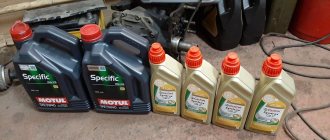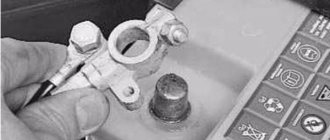How much oil should be poured into the engine
It is impossible to give a definite answer to this question. Vehicles of different manufacturers and brands have their own lubrication system design. In addition to the crankcase, the oil fluid is located in the pipeline, filter, crankshaft, and other components. How many liters of oil you need to pour into your own engine can be found in the operating manual. This is true when you need to fill the lubricant for the first time. The manufacturer indicates the proper filling rate if the power unit is hollow, just assembled.
After draining the oil solution from the system, some of it remains not drained. This is 300-500 grams of lubricant. It is possible to determine how many liters of oil to pour into a car engine by following the recommendations developed for this. Engines of domestic cars with a volume of 1.8 to 2.4 liters can contain from 3.5 to 4.0 liters of oil fluid. The same imported power units will contain from 4.0 to 4.3 liters of lubricant. To determine how much oil is in the engine, you need to use a dipstick and perform several steps:
- You must initially pour 3.5-3.8 liters of lubricant into the filler neck.
- Wait 2-3 minutes and check the level of the lubricant solution with a dipstick.
- If the value is insufficient, then you need to add 100-200 grams and check the degree of filling again.
The procedure must be repeated until the desired filling level is achieved. When pouring lubricant, you must remember that it is better to add little by little than to immediately overflow. Pumping back the lubricant from the system is a very problematic task. If too much lubricant enters, it will flood the engine parts and components near it. This will lead to foaming of the oil and heavy operation of the power unit. If the filling indicator is less than normal, the rubbing components and parts will quickly wear out.
Why is motor oil poured into the engine?
Synthetic motor oil
Before moving on to the main question, let’s determine why motor oil is poured under the hood of a car. The fact is that during operation of the entire propulsion system, each of its metal elements is subjected to large temperature overloads: the rapid interaction of parts causes a high friction force, which has a destructive effect on the entire motor. The lubricant, which has a viscosity determined by the manufacturer, fills all the gaps between the elements, thereby activating the protective layer between them. Thus, the friction force is reduced, the temperature inside the housing returns to normal, and the entire unit operates with maximum service life.
Determine oil level - methods
To find out the amount of oil in a car engine, several requirements must be met. They are mandatory:
- the car must be placed on a level surface;
- the power unit must be cool. If the check is carried out after stopping the vehicle, then you must wait 15-20 minutes. During this time, the temperature of the starting unit will decrease, the pressure in the lubrication system will drop, and the oil solution will drain into the crankcase;
- The lubricant level must be measured using a standard dipstick.
There are marks on the surface of the probe: min and max. They indicate the minimum and maximum permissible filling volume of oil in a car engine. The process of determining the lubricant level consists of the following points:
- The dipstick must be removed from its regular place and the remaining lubricant must be wiped off with a clean rag.
- Install the measuring rod in its original place.
- Remove the gauge again and inspect the oil layer. It should be located between the min and max marks.
- If the lubricant layer is below the minimum mark, then an oil solution must be added to the lubrication system.
- If the lubricant level is above the maximum mark, excess lubricant must be drained from the system.
Nowadays, almost all cars are equipped with computer warning systems for the presence of oil solution and its consumption. It is not recommended to completely trust computer data. Sometimes, especially before and after a long trip, you need to check the lubricant level in the power plant yourself.
Too high oil level: good or bad?
Let's talk about the situation when the fluid level on the dipstick is higher than o. And the reason for this may be the intentional overflow of fuel and lubricants, the inattention of the car owner, insufficient warming up of the car before changing the oil, etc. But first things first.
Removing the drain cover
Many drivers believe that the more oil in a car’s engine, the more power it produces. This opinion is wrong. If there is too much lubricant, the engine will simply choke. By the way, intentional oil overflow also occurs in situations where the structure has leaks and the driver is simply trying to immediately compensate for future losses.
Failure to comply with the required amount of oil may be caused by inattention or ignorance of the principle of filling it. Even after the last drop (as it seems to you) flows out of the crankcase, 200-300 ml of oil protection will remain in it (it can only be completely removed when disassembling the engine). Therefore, it is not recommended to fill the engine with fuel and lubricants (knowing in theory how much oil is needed for a given brand), focusing only on the canister marks.
An insufficiently warmed up engine can play a cruel joke on you and “not give” you all the liquid while draining it. The operating temperature inside the unit allows for improved circulation of the mixture and easier replacement.
Engine oil
A dipstick or excessive fuel consumption can be used to diagnose overflow. The last reason may be due to the fact that too thick a layer of working film will resist moving engine parts. Difficulty turning the crankshaft will cause a decrease in torque and, as a result, a decrease in vehicle power. To achieve rapid acceleration, the driver will press the gas pedal harder, but he will not achieve anything other than increased fuel consumption.
Among the consequences of fluid overflow, I would like to dwell on the most common ones. These include:
- Difficulty starting the engine. As mentioned above, due to a large amount of lubricant, the engine will “choke”.
- malfunction of hydraulic compressors.
- increase in pressure inside the motor system.
- excessive load on the oil pump, which is dangerous due to its rapid wear.
- the appearance of heavy deposits and soot in the working area and further contamination of the oil.
- increase in the concentration of harmful impurities in exhaust gases.
- Pouring spark plugs.
Intervals when you need to replace
The service book for the vehicle specifies the mileage after which the lubricant solution must be replaced. In the absence of intense operating conditions, driving on the highway outside the city, the mileage between lubricant changes can be up to 15,000 km. Operating vehicles in city traffic will reduce mileage to 9000-11000 km. But these data are not completely accurate, since the condition of the lubricant is influenced by several factors, which include:
- Type and quality condition of the fuel being filled.
- Power plant volume.
- The type of lubricant that was previously filled and its condition.
- The number of hours worked by the engine.
- Technical condition of the vehicle.
- Vehicle operating conditions and power plant operating modes.
These factors can change the quality of the lubricant. Loss of its characteristics by the lubricant will lead to rapid wear of the power plant. In such a situation, an analysis of the oil solution carried out in laboratory conditions can give an accurate answer about the quality of the lubricant and the need to replace it.
Separation of lubricants by origin
Today, all motor oils are divided by origin into mineral, synthetic and semi-synthetic. The latter type of oils is very common in the Russian Federation.
Experts advise that when using a motor, strictly follow the instructions for using a certain type of lubricant. Sometimes high-quality synthetics can damage the power unit instead of ensuring reliability and durability of its operation.
For example, if you replace mineral water with synthetics, you may run into trouble. Synthetic lubricant is not suitable for high mileage engines. Instead of reducing wear on the seals, it simply punctures them.
You need to be careful if you decide to choose semi-synthetics for a dead engine. It is better than mineral lubricant, but it is more fluid
This can have a bad effect on internal combustion engines with high mileage. In view of this, if you need to select oil for a worn-out engine, be sure to consult with an employee of the official dealership.
We recommend: What to do if the engine overheats?
If you have driven more than a hundred thousand kilometers in your car, you need to pour mineral water into the internal combustion engine. This is especially true for Russian cars. Remember that a worn engine uses a lot of lubricant. Mineral motor oil is inexpensive, so it is an excellent choice.
Semi-synthetics are a combination of mineral water and synthetics. For old Russian cars, its use is fraught with damage to the rubber parts of the engine. This is due to the fact that many aggressive additives are added to this type of motor oil.
The need for replacement according to engine hours
The initial data is the stable average speed of the vehicle in the city and the manufacturer's recommendations for changing the lubricant. Let's say the speed in the city is 40 km/h, and the factory recommendations for replacement are 15,000 km.
To calculate engine hours, you need to divide the distance by the speed limit. In this situation, 15000/40=375 m/h. The obtained value means that after 375 operating hours of the power plant it is necessary to change the oil.
The API international standard has developed a summary table for replacing oils, depending on their type and service life.
| Type of oil solution | Operating hours |
| Mineral | 130-150 |
| SyntheticARI SJ/SHAPI SL/SMPolyalphaolefinsEsters | 230-250320-350370-400430-450 |
| Semi-synthetic | 230-250 |
How many liters of oil do domestic car engines require?
If you can’t spoil the porridge with oil, then the car engine is a very capricious device in this regard. If the oil product is not added to the crankcase, the pump will not pump fully, and some of the cylinders will be dry. If you overfill it, the spark plugs will flood, the crankshaft will foam, causing the engine to stall. Or it won't start at all.
Most engines are picky about trying to mix different brands. Most often, such combinations lead to disastrous consequences, since additives added by manufacturers of different brands to improve the properties of oils react with each other, and the result of such reactions is unpredictable. As a result of chemical reactions of additives, viscosity deteriorates, an insoluble precipitate is formed, which negatively affects the lubricating properties and clogs the oil filter.
The volume of oil in the engine is 1.5-2.5 engine volumes, depending on its model and system.
Changing engine oil in GAZ cars
A veteran of the domestic automotive industry, the GAZ 21, although rare, is still found in its native open spaces. This car probably consumes the largest amount of lubricating oil - 5.5 liters.
Rolled off the assembly line of the Gorky Automobile Plant, it was replaced by the more modernized and elegant GAZ24, which was produced
- with engine type ZMZ-D24, and ZMZ-2401 in 1970-1986 with an engine capacity of 2.4 liters, requires 6 liters of oil to be poured into the engine;
- The ZMZ-2424 engine, twice as powerful as the previous ones and produced in 1985-1988, requires 8.7 liters to operate.
We recommend: Airbags: repair and restoration of triggered SRS elements
The ZMZ 406 engine, developed in 1993-1996, which is installed on GAZ-3105, 31105 and some GAZelles, requires 6 liters of engine oil.
The Volga has always been considered a representative, elite car; it was the most spacious of the passenger cars of the Soviet (and now Russian) automobile industry.
This car is distinguished by its solidity and reliability.
Oil in VAZ car engines
But when the country needed inexpensive cars accessible to ordinary workers, the AvtoVAZ plant appeared. The car itself is half the weight of the compact Volga, which means its engine is also more economical.
The very first model of the Zhiguli GAZ-2101, popularly nicknamed the “penny”, requires 3.5 liters of oil. For “two” and “three”, 3.5 liters is also enough.
As for the most popular Niva, which has been in production for 40 years, over the years this SUV has been equipped with engines of different sizes.
The oil volume for replacement in engines with a capacity of 1.6 and 1.7 liters is 3.75 liters. To change the oil in this car, a 4-liter canister will be enough. But an engine with a volume of 1.9 liters will already require 4.2 liters. A complete oil change on a Niva should be done once a year, or every 10 thousand kilometers.
The picture shows one of the latest models of an AvtoVAZ SUV, and it is equipped with a 1.7-liter VAZ 21214 engine. When leaving the assembly line, LUKOIL LUX mineral water with a viscosity of 10W-30 or 10W-40 is poured into the crankcase. This car requires 3.7 liters of petroleum product.
One of the latest models to penetrate the country's car markets, and at the same time, not very smooth roads, is the Lada Vesta.
In different trim levels, 3 different engines are installed - VAZ 21129, VAZ 21179 with a volume of 1.6 and 1.8 liters and a Japanese Nissan HR16 DE with a chain instead of a timing belt and a capacity of 1.6 liters. VAZ 21179 and the Japanese engine require 4.4 liters versus 3.2 for the VAZ 21129.
Need for replacement due to fuel consumption
The initial data should be fuel consumption per 100 km of movement according to passport data and actual. For example, according to the passport, consumption is 9 liters per 100 km, but the actual consumption is 11 liters. According to the passport, the oil change should be carried out every 15,000 km of vehicle movement.
Fuel consumption is calculated using the proportional method for passport and actual data separately. For passport data: 15000x9/100=1350 liters. For actual data: 15000x11/100=1650 liters.
The actual distance through which new oil must be filled is calculated by a similar proportion: 1350x15000/1650= 12270 km.
Each method can be used for any vehicle. It is only necessary to record the data at the moment of pouring lubricant into the motor.
Fuel
All that remains is to choose what gasoline to pour into the trimmer. The choice is small - AI-92 and AI-95. The difference between them is quite significant. If the manufacturer's instructions do not indicate which gasoline to use, then you need to stop at AI-92. It practically does not depend on the brand of gasoline how much oil you need to add per liter of gasoline, if the fuel is of high quality and fully corresponds to the declared brand. Buy gasoline only at branded gas stations, where the risk of buying A-80 instead of AI-92 is almost zero.
If it is recommended to fill with AI-95, then do not use other brands of gasoline. If the engine starts, it will run irregularly and quickly overheat. This way, you risk damaging the motor of not only a household trimmer, but also a professional one.
Let's sum it up
In order to determine how much oil to pour into a car engine, you must follow several recommendations:
- Choose a car oil for the vehicle that will be constant throughout its operation. The lubricant must be selected taking into account the operating conditions of the vehicle.
- If the vehicle is actively used, check the oil fill level using a dipstick at least once every 3-4 days.
- Monitor the interval between runs when replacing the lubricant.
- Fill the engine with lubricant in accordance with technology. Do not underfill or overfill the solution.
- If you lack experience, knowledge or doubt, contact a service station that has the necessary equipment. Specialists will carry out the necessary work on the engine, regardless of whether it is diesel or gasoline.
Compliance with the recommendations guarantees long-term operation of the power unit.
Why is the minimum engine oil level dangerous?
By measuring the volume of oil filled with a dipstick, you may find that the amount does not reach about. Why is this dangerous? The fact is that a low level of lubricating fluid cannot provide the necessary protection to all elements of the engine structure. In other words, the thickness of the oil film will be much less than required, and, perhaps, will not be able to form at all, thereby increasing the “dry” friction of the mechanisms. Rapid wear of working units, increased temperature inside the unit housing and crankshaft jamming are the main consequences of insufficient oil level.
Optimal oil level
A sharp decrease in fluid due to engine problems can be diagnosed by an oil pressure light located on the dashboard of any car. However, its activation occurs only if the leak is large-scale. If the housing lacks 200-300 ml of lubricant, you can only find out about this using a dipstick.
Symptoms of low oil levels are:
- the appearance of extraneous noise in the operation of the car,
- clearly audible knocking sound in hydraulic compressors,
- excessive increase in oil temperature and constant operation of cooling radiators.
If the reason for the low filling volume lies in a simple underfilling of oil fluid, then the solution is simple - add the required volume so that the oil level on the dipstick is between o and “max”. However, if you notice a regular lack of fuel and lubricants, then there is a hidden problem. You can diagnose it yourself or with the help of a car repair shop.











